Britain’s hangman who sent the Beasts of Belsen to hell: How Albert Pierrepoint executed 13 Nazis on a single day in 1945 and killed 200 war criminals in total (as well as Hitler’s propagandist Lord Haw Haw)
It was December 1945 and Albert Pierrepoint literally had the biggest job of his life on his shoulders.
The British executioner – the methodical killer who was skilled with his tools – had been sent to Germany to execute 13 depraved Nazi war criminals.
The greatest among them was Josef Kramer, who, in almost his last act as commandant of the Bergen-Belsen concentration camp, executed 22 defenseless prisoners with a machine gun.
Irma Grese, a 21-year-old guard, carried a whip with which she beat prisoners to death.
Dr. Fritz Klein, a 55-year-old Romanian physician, had worked alongside Kramer at Auschwitz and then at Belsen. The rabid anti-Semite chose who would be forced to work and who would die.
The others on Pierrepoint’s list included Juana Bormann (who had a pack of dogs that would hunt down prisoners) and Elizabeth Volkenrath, who, as commandant of the women’s camp at Auschwitz, beat prisoners to death with her fists.
All the murderers had been sentenced to death at the Belsen trials in Lüneburg, Germany. They were just a handful of the 200 Nazis Pierrepoint eventually executed.
A month after the Belsen war criminals were hanged, Pierrepoint executed the American-born traitor William Joyce, who became known as Lord Haw-Haw for his tireless dissemination of Nazi propaganda.
It was December 1945 and Albert Pierrepoint (above) had the biggest job of his life on his hands – literally. The British executioner – the methodical killer who wielded his tools of the trade with dexterity – had been sent to Germany to execute 13 depraved Nazi war criminals.
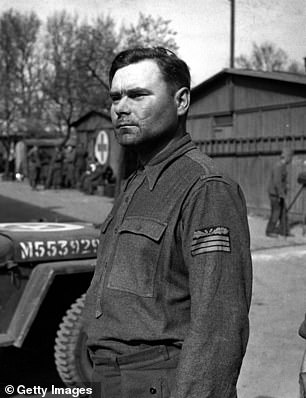
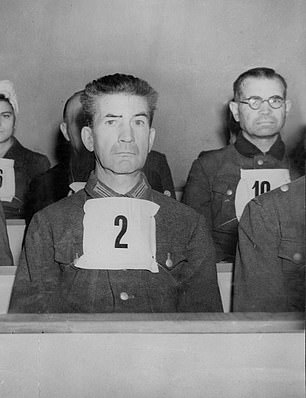
In almost his last act as commandant of the Bergen-Belsen concentration camp, Josef Kramer (left) executed 22 defenseless prisoners with a machine pistol. Dr. Fritz Klein chose who would be forced to work and who would die
This week, lawyer and TV star Rob Rinder said he changed his stance against the death penalty after learning about Pierrepoint, who hanged a Nazi responsible for torturing his grandfather.
Mr Rinder’s Jewish ancestors – great-grandparents, four great-aunts and a great-uncle – were murdered in the Treblinka extermination camp during the Holocaust.
His grandfather, Morris Malenicky, escaped from the death camps because he was a teenager and could work, and was therefore forced into slave labor in the Buchenwald concentration camp.
Mr Rinder discovered Pierrepoint while researching his latest programme, Britain Behind Bars: A Secret History.
After discovering that Pierrepoint had sent one of Buchenwald’s commandants, who was ‘responsible for torturing my grandfather’, Mr Rinder said: ‘It changed my opinion (against the death penalty).
“It made me less certain (and less clear) that the issues are complex.”
Pierrepoint worked as a greengrocer before following in his father and uncle’s footsteps and becoming an executioner.
In late 1945, the British had only just learned of the war crimes committed in Nazi Germany’s execution camps.
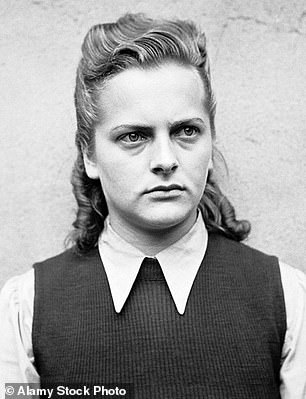
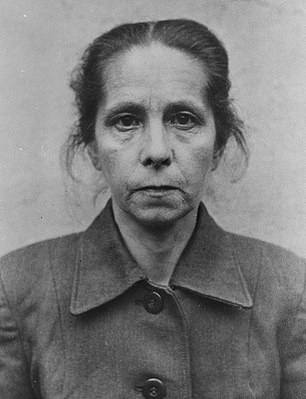
Irma Grese (left), a 21-year-old guard, carried a whip with which she beat prisoners to death. Juana Bormann kept a pack of dogs that were turned loose on prisoners
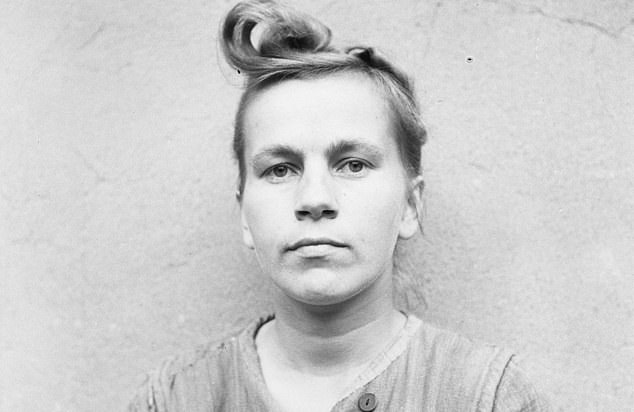
Elizabeth Volkenrath was the commandant of the women’s camp at Auschwitz before she moved to Belsen. She beat prisoners to death with her fists
Radio and newspaper reports of the horrors at Belsen – first reported by Richard Dimbleby on the BBC – had shocked the nation.
Press interest in Pierrepoint’s trip to Germany was enormous. He described the group of reporters who followed him to his plane as ‘about as unwelcome as a lynch mob’.
For his special role, Pierrepoint was given the rank of lieutenant colonel.
The convicts were held in a row of small cells built by the Royal Engineers.
Kramer had first served as an SS guard at Dachau. In 1940, he was an assistant to Rudolf Hoss at Auschwitz in Nazi-occupied Poland.
He was put in charge of the gas chambers and would later describe at his trial how 80 women “began to scream” as the cyanide gas Zyklon-B began killing them.
He said: ‘I put a small amount of salt through a tube into the chamber and looked through a peephole to see what was happening.
“The women were breathing for about a minute before they fell to the ground. I had no feelings about doing these things because I was under orders.”
Kramer moved to Belsen in Germany in December 1944. As camp commander, he was called the Beast of Belsen by the prisoners.
Prisoners who did not respond immediately to an order were beaten, whipped or shot.
Klein divided prisoners between those who would live and those who would die and also selected naked women for the SS brothel.
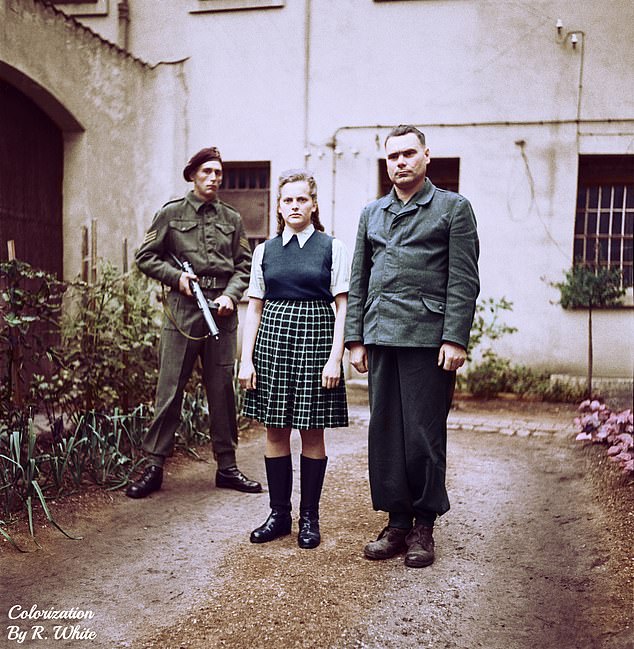
Nazi murderers Josef Kramer and Irma Grese, pictured, were hanged in Hamelin, Germany, on December 13, 1945, by Albert Pierrepoint
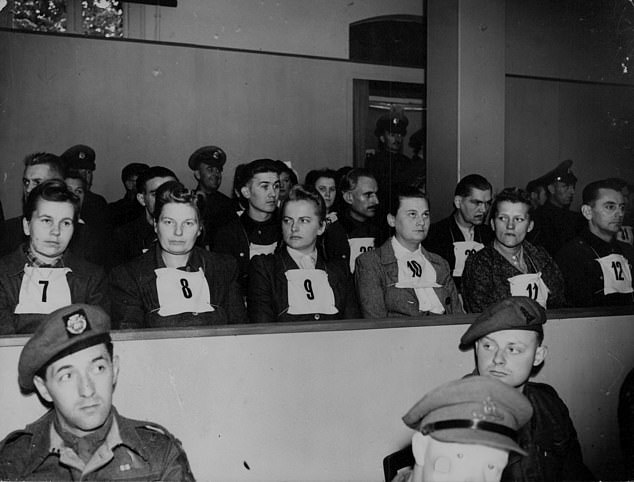
Suspects at the Belsen War Crimes Trial in Lüneberg, Germany (Grese is number 9 and Volkenrath is number 7)
He referred to his duty as a physician: ‘My Hippocratic Oath tells me that I must remove gangrenous appendicitis from the human body.
“The Jews are the gangrenous appendage of humanity. That’s why I cut them out.”
When Belsen was liberated by British troops, Klein tried to pose as a charity worker by wearing a Red Cross armband.
After survivors pointed him out, he was forced to dig mass graves.
Pierrepoint said that the blonde Irma Grese was ‘the most beautiful girl you could wish for.’
A fellow guard claimed that Grese killed at least 30 people a day. Like Bormann, she kept dogs trained to tear people apart.
Volkenrath, who later worked at Belsen, was, according to survivors, “the most hated woman in the camp.” The 26-year-old devised a punishment she called “sportsmanlike.”
In this, prisoners were forced to exercise until they dropped.
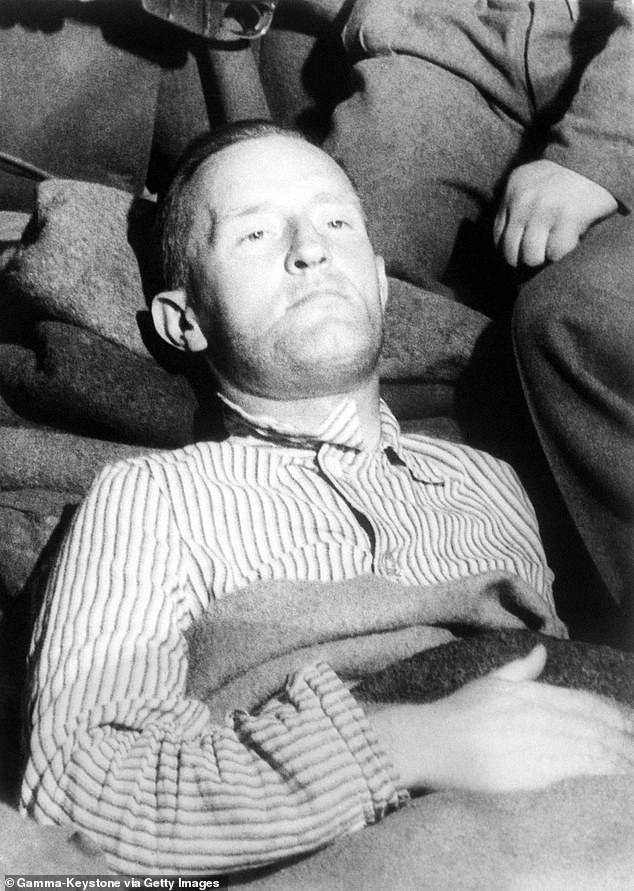
A month after the Belsen war criminals were hanged, Pierrepoint executed the American-born traitor William Joyce (above), who became known as Lord Haw-Haw for his tireless dissemination of Nazi propaganda
Pierrepoint spent much of his day in the prison, where the prisoners were held to prepare the noose for each of them.
Each rope was measured to ensure that the condemned would fall the correct distance to break their necks cleanly.
Because each execution could be heard by the other prisoners, Pierrepoint made sure that the women were hanged first so that they would suffer less.
On Friday, December 13, he first hanged Volkenrath. Then he moved on to Grese. He later wrote in his autobiography: ‘She walked into the execution chamber, stared for a moment at the officials standing around, then walked to the center of the trap where I had drawn a chalk line.
‘She stood very firmly on this mark and when I placed the white cap on her head she said in a languid voice: “Schnell”.’
After the third woman was hanged, Pierrepoint paused for a cup of tea. Then Kramer was executed.
It was already dark when the last of the thirteen bodies were removed from their rope.
Then officials realized that only 12 coffins had been delivered, so the last body was wrapped in burlap for burial.
In late 1946, Pierrepoint and his wife took over a pub outside Manchester called Help The Poor Struggler.
He would remain Britain’s chief executioner for another ten years, but he always refused to talk about his work.
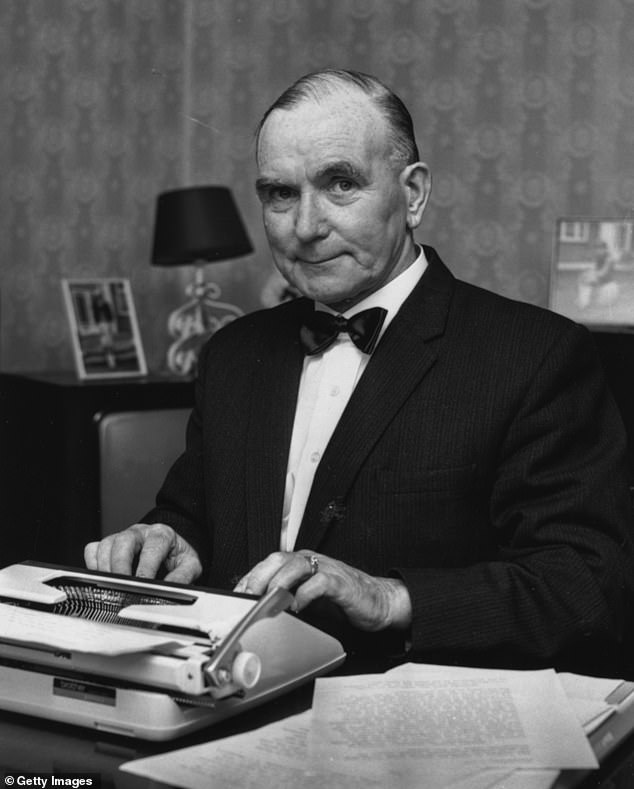
In his autobiography, Pierrepoint admitted that he did not believe in the death penalty. He died in 1992 at the age of 87.
Other people he hanged included serial killers John Christie and John Haigh, who was known as the ‘Acid Bath Murderer’.
He also put an end to Ruth Ellis, the last woman to be hanged in Britain.
Last year, the notebook in which Pierrepoint recorded the name, age, height, weight and notes on the neck type of each person he hanged sold at auction for £12,400.
In his autobiography, Pierrepoint admitted that he did not believe in the death penalty. He died in 1992 at the age of 87.
